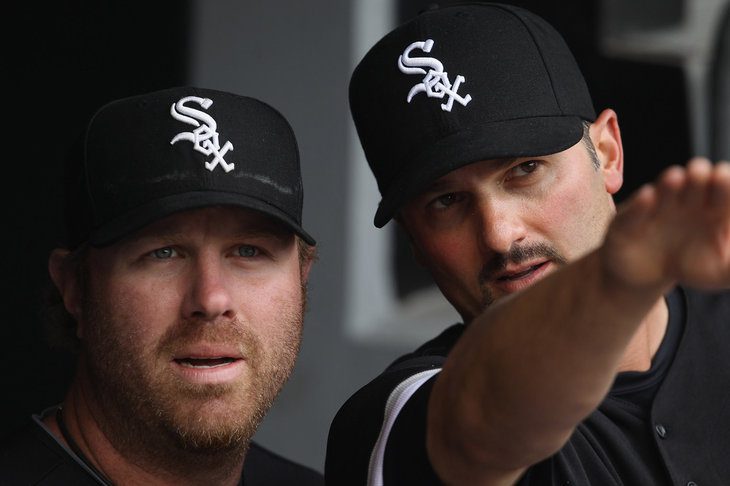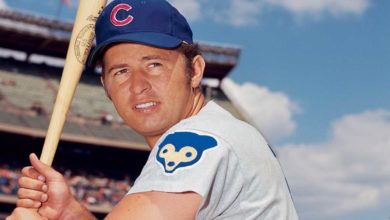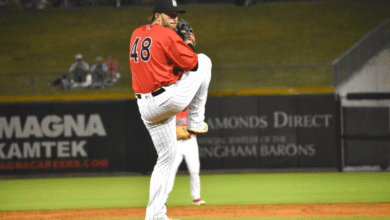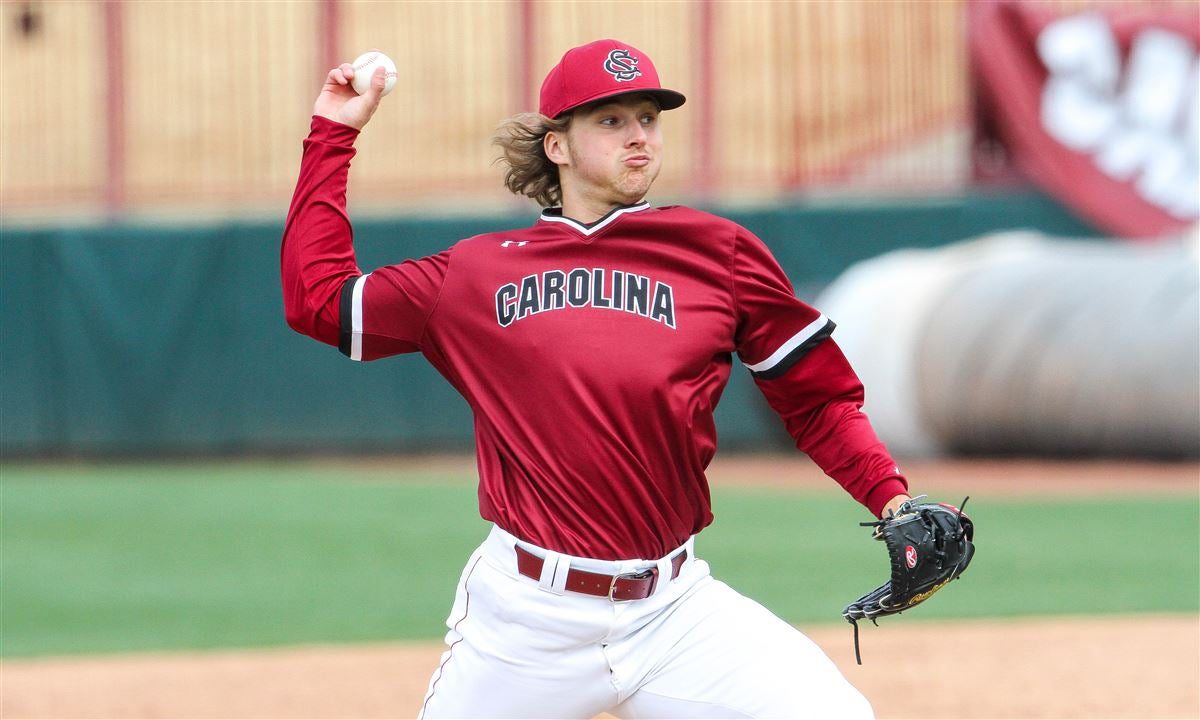

The Chicago White Sox have a tendency to do what you don’t expect them to do. The 2011 club failed to live up to the expectations which were placed on it after they re-signed franchise favorites A.J. Pierzynski and Paul Konerko, while also adding Adam Dunn, a slugger whose offensive profile suggested he was a perfect fit for US Cellular Field.
That team struggled to get off the ground as Dunn had a historically bad offensive season and the White Sox finished third in the American League Central.
So, the bar was set exceptionally low for the 2012 season. The club seemingly got worse in the offseason as they lost rotation stalwart Mark Buehrle and replaced two offensive starters, Carlos Quentin and Juan Pierre, with a raw rookie in Dayan Viciedo and a relative unknown commodity in Alejandro De Aza.
Chicago White Sox general manager Kenny Williams was hinting at the dreaded “r word” (rebuilding) at the start of 2012, but all talk of a South Side tear down ceased with a hot start, which sustained itself throughout the season. The White Sox surprised everyone (perhaps even themselves) en route to finishing three games out of a division that seemed gift-wrapped for the Detroit Tigers.
Now, the Chicago White Sox are once again underdogs in a weak division. Williams has kicked himself upstairs and promoted the highly regarded Rick Hahn to GM. The American League Central is run by the Detroit Tigers who will get better with the additions of Victor Martinez and Torii Hunter this offseason. The Chicago White Sox made minimal moves this offseason which was highlighted by the acquisition of Jeff Keppinger.
Chicago White Sox position players
The loss of Pierzynski will sting the offense quite a bit as his productive .278/.326/.501 slash line will be extremely difficult to replace. Tyler Flowers will take over the catching duties, and while Chicago White Sox pitchers have praised the way Flowers calls a game, he hasn’t exactly inspired much confidence in his bat during his brief career. The power is obvious with Flowers, but there are concerns his meager contact rate, he was striking out 36.6% of the time last year, will undercut his offensive production.
Konerko is often praised for having an extremely professional approach at the plate, and his complete control of the strike zone demonstrates masterful control of what he swings at. Konerko has a shape in mind when he steps to the plate, and he will rarely chase pitches out of his zone. If you get the chance watch his AB’s closely, pay attention to the pitches he swings at and the pitches he doesn’t. Konerko suffered a pair of unfortunate injuries in 2012. Jeff Samardzija hit him in the face with an errant fastball, and he developed a wrist injury in June that sapped his power. Konerko was slugging .617 on June 3 before having a procedure on his wrist to flush debris. He slugged .403 the rest of the way, and as his slugging went, so too did the Chicago White Sox winning percentage. Konerko should have another good year as the skills he relies on have not eroded. He still has a tremendous eye at the plate and a great approach. The only question mark is his health.
Gordon Beckham has failed to live up to the hype he generated after a strong rookie season in 2009. Beckham was drafted as a shortstop, moved to third and has settled in as a fine defensive second baseman. Beckham doesn’t have a ton of range, but he is sure-handed and able to get to enough balls to be a positive. The disappointing issue is his lack of offense. Beckham started 2012 by posting a nightmarish slash line in April: .153/.231/.203. He rebounded in May, but he had an uneven season overall and finished with a very pedestrian stat line. Beckham has failed to make any re-adjustments after the league figured him out in 2010 and is still susceptible to losing the AB early and putting himself in bad hitter’s counts.
Keppinger will fill in at thirdbase for the White Sox as Kevin Youkilis outpriced himself and Brent Morel does not seem ready for major-league pitching. Keppinger is a slappy hitter who doesn’t walk or strike out often. The White Sox see him as an offensive upgrade over Morel, however, and this organization does have a soft spot for utility infielders (Brent Lillibridge anyone?) so Keppinger will be given every chance to win the starting job.
When Alexei Ramirez first came up, he was a hit-first defensive butcher at shortstop whose glove would likely necessitate a move off the position. The Chicago White Sox tried him all over the field in his rookie season before throwing their hands up and living with the mistakes at short. Ramirez has rewarded them by becoming a dependable defender and adding some valuable pop at a premium position. His 2012 never got going offensively, and Ramirez will have to answer some questions about his stick in 2013. Ramirez is regarded as a slow starter as he often doesn’t heat up until the temperature does. He did hit well in the middle months of the season but the Chicago White Sox will need more from his bat to cover for some lost production. Ramirez is known as a free swinger, and his glove does make up for his uneven offense, but he will need to draw more than 14 unintentional walks if he wants to return to form.
Dunn had a disastrous 2011, so his “rebound” in 2012 seemed like a godsend for the Pale Hose. Dunn inched up his production by increasing his batting average but his peripherals are still alarming. It appears Dunn has permanently crossed the 30% K-rate threshold and won’t be returning ever again. Dunn always had an old player’s skill set: bombs, walks and strikeouts. He’s only getting older, so it’s likely that 2012 was a dead-cat bounce and not an upward trend.
The outfield will be manned by De Aza in centerfield, Viciedo in left field and Alex Rios in right. De Aza has been a revelation for the Chicago White Sox. His offense is more than adequate for the leadoff spot and he plays good defense in center. Rios is an enigma. He’s a scouting dream with his size — and his obvious and loud tools — but he has never put together and extended run of success. Rios is becoming an “every other year” player, and this is slated to be the down year. His peaks are extraordinarily high and pleasing, but the valleys are low and dangerous. Viciedo has the chance to become something very special. He has a quick bat and prodigious power. He flashed signs of competence last year and held his own at the major-league level. Viciedo has the tools to succeed, but his patience will dictate how high his ceiling gets. His walk rate was absurdly low last year.
Chicago White Sox pitching
Any evaluation on Chris Sale begins with his delivery and ends with the writer expressing absolute fear the “fragile one” will break down at some point this year as the workload proves to be too much. Sale famously had a tiff with then-GM Kenny Williams after he was to be demoted to the bullpen.
After decision was made by Sox staff to move Sale to bullpen, Chris called Williams and convinced him to let him back in rotation.
— Chuck Garfien (@ChuckGarfien) May 11, 2012
Sale rewarded the Chicago White Sox by surviving the season, and the Sox rewarded Sale by paying him in the offseason. The best predictor for future injury is past injury, so until Sale suffers a serious one, it is folly to predict an injury based on his mechanics. The injury risk is present, but it is not definite. Instead, let’s evaluate Chris Sale the pitcher. Sale did wear down as the season progressed, losing velocity on his fastball in the second half, but he held his own despite the loss of stuff. Sale posses a truly elite slider, and if he can develop the change-up a bit further, he will be absolutely deadly.
Jake Peavy has made the transition from super-ace to super-two quite nicely. Peavy no longer possesses the truly dominant ace stuff, but he has developed an almost surreal pitchability. The main concern with Peavy is which one shows up in 2013. He has a history of attempting to pitch through injuriesm which is both admirable and a detriment to the team.
The Chicago White Sox finally gave a pitcher a long-term deal, and then the recipient of the long-term deal proceeded to get hurt early in the season and go down for the year while only logging 53 innings. John Danks was the Chicago White Sox workhorse before the emergence of Sale and his injury. This year will be about making a comeback and becoming an adequate three starter.
Floyd and Jose Quintana are charged with holding down the backend of the Chicago White Sox rotation. The puzzling Gavin Floyd has one of the best curveballs in baseball and backs it up with a good fastball, but his results never seem to match the stuff. Quintana was a big surprise last year as the White Sox were desperate for pitching after Philip Humber imploded and the Sox suffered a string of injuries. Quintana started hot but cooled as the league adjusted to him. Quintana never had dominating stuff, and he relies on location and guile. It’s time for him to readjust and come up with some new tricks as the league has caught up to the old ones.
The closing duties will likely fall on the shoulders of Addison Reed once again, but the Chicago White Sox aren’t afraid to change horses midstream as they demonstrated last year when Matt Thornton faltered in the role. Reed and Thornton both possess end-of-game stuff, and it’ll be interesting to see what manager Robin Ventura does if Reed has issues early in the season. The bullpen is a strength for this team as it boasts a super LOOGY in Donnie Veal and a few good arms in Nate Jones, Jesse Crain and recent acquisition Matt Lindstrom.
Chicago White Sox opening day lineup
- Alejandro De Aza CF
- Jeff Keppinger 3B
- Alex Rios RF
- Paul Konerko 1B
- Adam Dunn DH
- Dayan Viciedo LF
- Alexei Ramirez SS
- Tyler Flowers C
- Gordon Beckham 2B
- Chris Sale SP
Chicago White Sox prospect watch
The Chicago White Sox are correctly derided for having a barren farm system. Their farm ranked dead last according to Baseball Prospectus in 2012. Even with an awful system ranking the White Sox do have interesting talent down on the farm. They lack depth, not top-level talent.
Courtney Hawkins is the consensus top prospect in the Chicago White Sox system. Hawkins is most noted for his backflips, but he might soon grow out of those in the physical sense, if not the mental sense. Hawkins projected to have a big body and will lose more athleticism as he ages. It won’t matter too much because his bat projects to have enough power to support his move from center to a corner outfield spot.
Carlos Sanchez is impressing everyone of late. Sanchez is a slick-fielding second basemen with line-drive gap power and good speed. Sanchez needs to learn how to harness his speed tool and utilize it better. His caught stealing rates are too high for someone gifted with his speed. Sanchez is one to keep an eye on.
Jared Mitchell is a familiar model in the Chicago White Sox system: superlative tools with mixed results. Mitchell has all the makings of a borderline all-star center fielder but he hasn’t put it all together for a solid season in the minors yet. He suffered an injury that robbed his 2010 season, and he will have to put in a lot of work to regain his prospect status in 2013.
Trayce Thompson is another Chicago White Sox prospect with loads of power. Thompson will face his first test in double-A Birmingham. Should he pass the test, be prepared to see him skyrocket up prospect lists and perhaps up the White Sox depth chart.
Prediction
The Chicago White Sox’ greatest strength is their ability to keep their players, specifically their pitchers, on the field. That was tested last year, but with surprising contributions and the Youkilis trade, the White Sox were able to remain in contention for most of the year before succumbing to the Konerko power outage and Quintana’s regression to the mean.
It will not be easy for the Chicago White Sox in 2013. The Detroit Tigers are adding Victor Martinez to an already vicious offense and will likely get some help defensively with the addition of Torii Hunter in right field. Detroit also boasts a magnificent rotation that the Sox will have to match if they want to truly compete in the divison.
On paper, the Chicago White Sox’ greatest strength is their starting pitching, but it is a precarious advantage full of question marks. Most of the weight will fall on Sale and Peavy to surpass their performances last year. Sale will almost certainly have to pass the 200 innings-pitched threshold and Peavy will have to take the bump 32+ times if the Chicago White Sox want to make the playoffs. The pressure also falls on Danks to provide a stabilized load of innings. The top three will have to be close to dominant so the Sox can stay in games when the offense falters.
The offense is, without a doubt, the biggest question mark on the team. The projected lineup boasts four starters who posted sub-.300 OBP’s last year, which is a recipe for disaster. The addition of Keppinger should help, but the Chicago White Sox will have to hope on a few things turning out positive for them. They must hope Dunn does not fall off the age cliff and Rios does not regress to his 2011 numbers. Konerko must also provide 140+ games of typical Konerko production. Viciedo must take a step forward and Ramirez needs a return to form offensively.
The Detroit Tigers are rightfully the favorites for the American League Central crown, and it’s hard to imagine a scenario where the Chicago White Sox take it from them, even if everything breaks right. It’s likely the White Sox will have to hope that fortune smiles on them and they can maximize the talent on the roster once again and enjoy a ride in summer relevance, which will hopefully lead to autumn glory.
The Chicago White Sox have the cards stacked firmly against them, and it would be an utter shock if they find themselves in contention when September rolls around. If there’s one team that has shown the ability to do what its not expected to do it is the Chicago South Side Squad.
My prediction: 88-74, second wild card spot.





